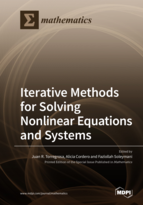Iterative Methods for Solving Nonlinear Equations and Systems
A special issue of Mathematics (ISSN 2227-7390).
Deadline for manuscript submissions: closed (30 September 2019) | Viewed by 87504
Special Issue Editors
Interests: iterative processes; matrix analysis; numerical analysis
Special Issues, Collections and Topics in MDPI journals
Interests: numerical analysis; iterative methods; nonlinear problems; discrete dynamics, real and complex; fractional iterative methods; chaos and stability in iterative procedures; fractal dimensión in Julia sets
Special Issues, Collections and Topics in MDPI journals
Interests: numerical linear algebra; option pricing PDEs; computational methods for SDEs; iterative methods
Special Issues, Collections and Topics in MDPI journals
Special Issue Information
Dear Colleagues,
Solving nonlinear equations and systems is a non-trivial task that involves many areas of Science and Technology. Usually, it is not affordable in a direct way, and iterative algorithms play a fundamental role in their approach. This is an area of research that has experienced exponential growth in the last years.
The main theme of this Special Issue, which is not the unique, is the design, analysis of convergence, and stability and application of new iterative schemes for solving nonlinear problems to practical problems. This includes methods with and without memory, with derivatives or derivative-free, with real or complex dynamics associated with them and an analysis of their convergence that can be local, semi-local, or global.
Prof. Dr. Juan R. Torregrosa
Prof. Dr. Alicia Cordero
Dr. Fazlollah Soleymani
Guest Editors
Manuscript Submission Information
Manuscripts should be submitted online at www.mdpi.com by registering and logging in to this website. Once you are registered, click here to go to the submission form. Manuscripts can be submitted until the deadline. All submissions that pass pre-check are peer-reviewed. Accepted papers will be published continuously in the journal (as soon as accepted) and will be listed together on the special issue website. Research articles, review articles as well as short communications are invited. For planned papers, a title and short abstract (about 100 words) can be sent to the Editorial Office for announcement on this website.
Submitted manuscripts should not have been published previously, nor be under consideration for publication elsewhere (except conference proceedings papers). All manuscripts are thoroughly refereed through a single-blind peer-review process. A guide for authors and other relevant information for submission of manuscripts is available on the Instructions for Authors page. Mathematics is an international peer-reviewed open access semimonthly journal published by MDPI.
Please visit the Instructions for Authors page before submitting a manuscript. The Article Processing Charge (APC) for publication in this open access journal is 2600 CHF (Swiss Francs). Submitted papers should be well formatted and use good English. Authors may use MDPI's English editing service prior to publication or during author revisions.
Keywords
- nonlinear problems
- iterative methods
- convergence
- efficiency
- chaotic behavior
- complex or real dynamics








